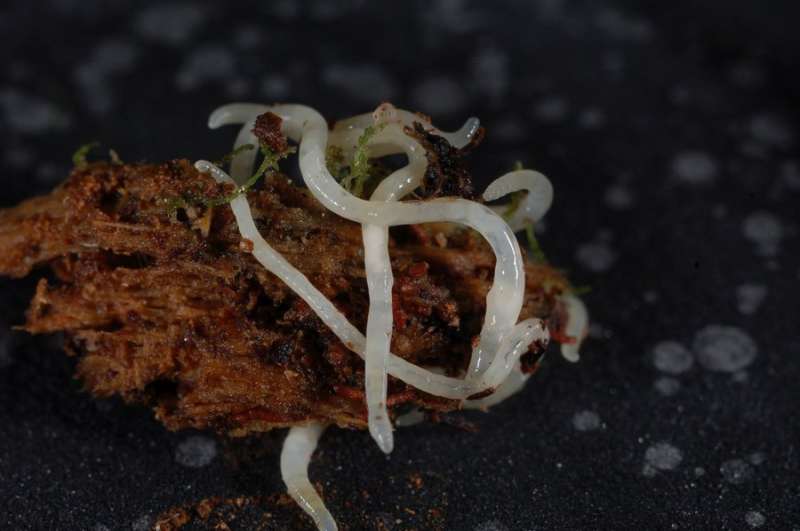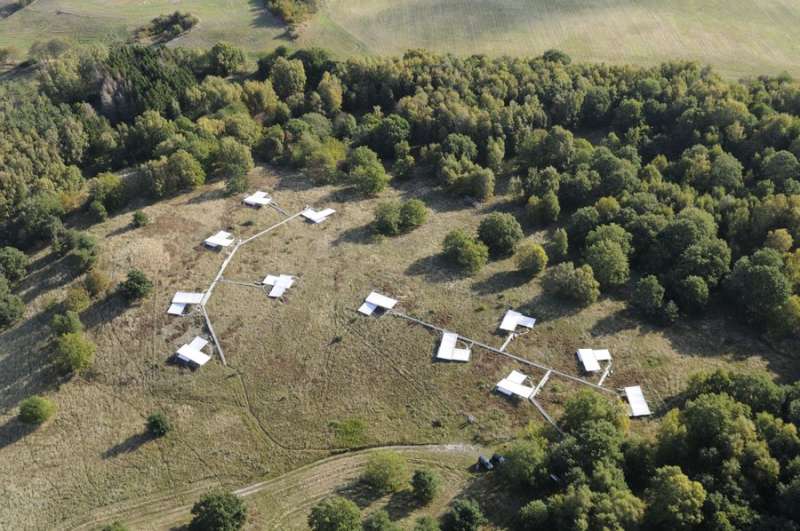Slow worms react quickly to climate change

Evolution can go quickly when it has to - at least for small organisms. Researchers exposed a natural setting in Denmark to artificial climate change and discovered that soil just half a degree warmer caused the genome of small worms to change surprisingly quickly.
Can evolution keep up with the current rapid climate change? The answer to this question is very important regarding the animals, plants and microorganisms that we humans will share the planet with in future.
Researchers at Aarhus University have now unravelled part of the answer from some small worms.
For seven years, the worms were exposed to a warmer and drier climate - partly forced by the ingenious use of waterproof curtains - in an experimental area near the Danish town of Jaegerspris. The impact on their genes is clear. A total of 12 per cent of the genetic changes the researchers found in the worms could be directly attributed to the small changes in the soil temperature and moisture.
"It was surprisingly fast, especially in light of the fact that the soil only became half a degree warmer. And it's worth emphasising that the changes were only caused by the direct impact of the 'climate change', and not a bottleneck in the populations due to drought," says Associate Professor Thomas Bataillon, Bioinformatics Research Centre (BiRC), Aarhus University.
He is the main author of an article about the project that has just been published in the scientific journal Global Change Biology.
Rapid development without sex
The species of worm is Chamaedrilus, which belongs to the Enchytraeidae family. It is common throughout most of the world and plays a major role in the aerobic digestion of organic material.
The researchers are unable as yet to say what the genetic changes mean for the individual worms in a purely practical sense - whether they have become better at coping with heat, for example. There are no visible differences between the worms whose 'forefathers' lived under the waterproof curtains and their fellow species that lived elsewhere.

Incidentally, using the word 'fathers' is a misrepresentation because this species mainly reproduces asexually - the worms clone themselves by dividing into small sections. They presumably do this four times a year, depending on the conditions.
And something that is equally important - the Chamaedrilus moves both slowly and reluctantly, so the experiment was not contaminated by emigration and immigration.
The researchers were therefore able throughout the seven years to analyse the genetic changes from between 15 and 30 generations - and evolution was better able to keep up during this time than it would have been if other organisms had been used with a slower reproduction rate.
It is therefore impossible to immediately apply the results from this little worm to other species.
However, the method can be applied - at least for organisms that are small and stationary enough to be used for experiments.
Better data
"As far as we know, our studies are the first that use gene sequencing to quantify evolution in a scientifically validated field experiment under natural conditions. In previous studies of the impact of climate change on natural selection, researchers have either carried out laboratory experiments with a few selected model organisms (e.g. fruit flies), or have made assumptions based on the biodiversity in geographical locations where the climate is already warmer. Our method can provide more realistic data for the models that calculate the impact of climate change on life on Earth. Evolution should therefore be built into these models as well," says Associate Professor Bataillon.
He adds that the new data can possibly imply that the previous models might exaggerate the risk of some species becoming extinct due to climate change in the coming years.
"However, many more studies are required, and there will no doubt also be species that do not prove to be capable of adapting. The most important thing is that our predictions about the biodiversity of the future get more accurate," says Associate Professor Bataillon.
More information: Thomas Bataillon et al, A replicated climate change field experiment reveals rapid evolutionary response in an ecologically important soil invertebrate, Global Change Biology (2016). DOI: 10.1111/gcb.13293 Thomas Bataillon et al. A replicated climate change field experiment reveals rapid evolutionary response in an ecologically important soil invertebrate, Global Change Biology (2016). DOI: 10.1111/gcb.13293
Journal information: Global Change Biology
Provided by Aarhus University


















